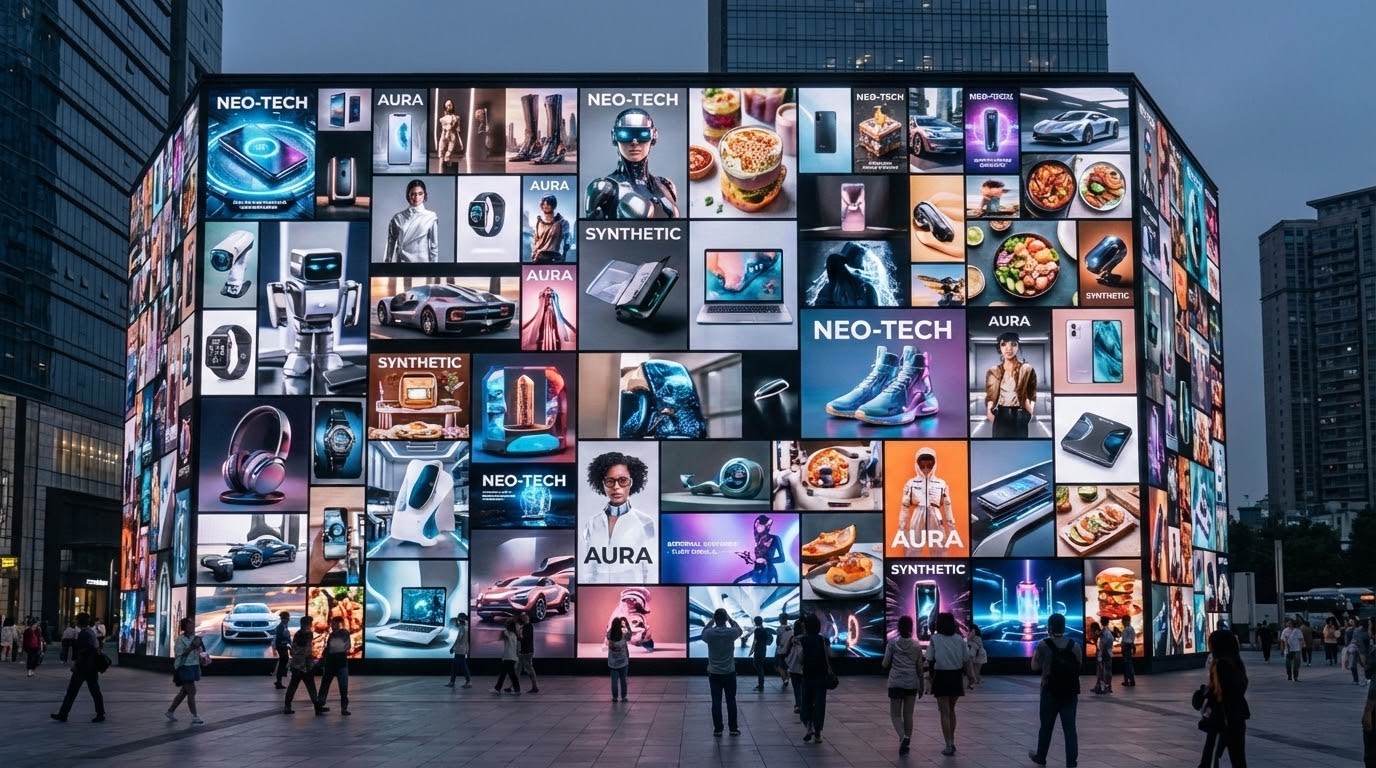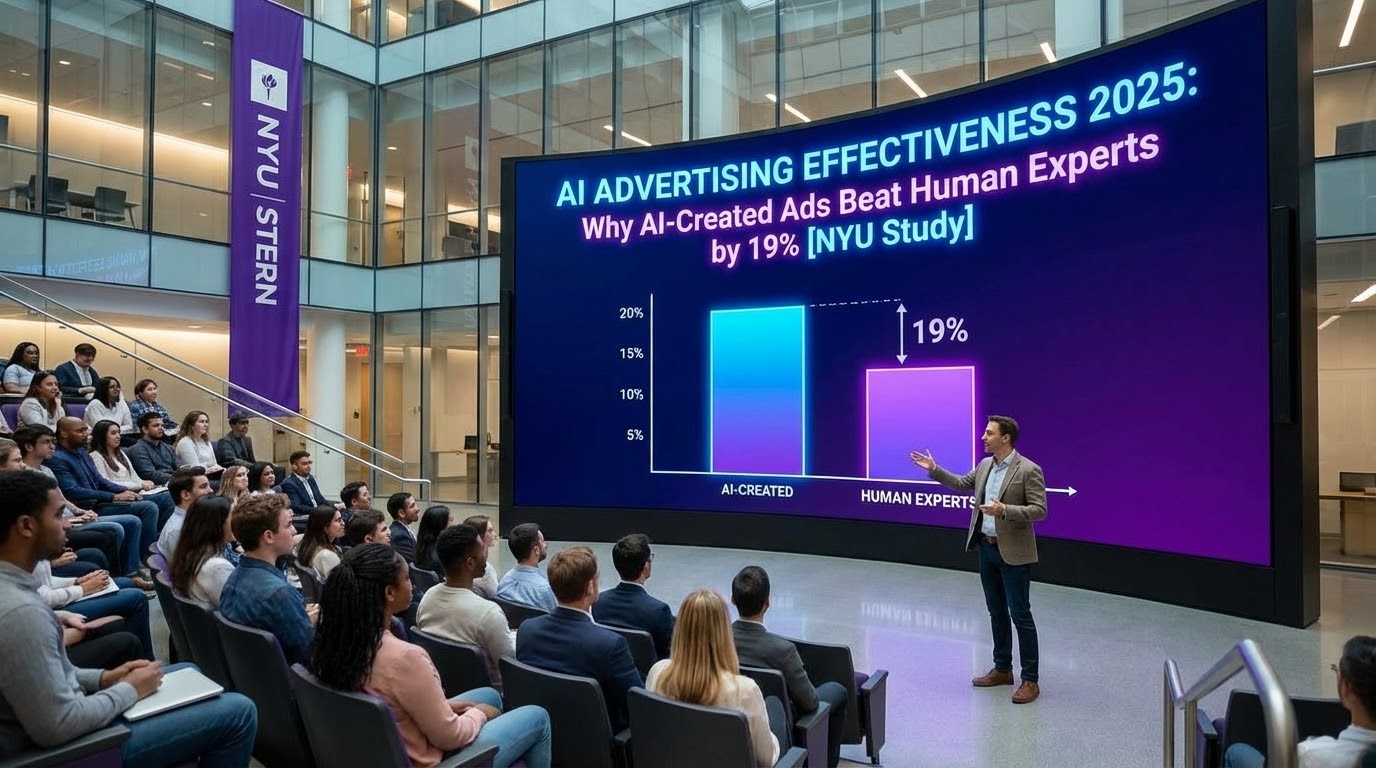
AI Advertising Effectiveness 2025: Why AI-Created Ads Beat Human Experts by 19% [NYU x Emory Study]
Why your AI-modified ads are failing — and what top e-commerce brands are doing instead
A groundbreaking study from NYU Stern and Emory University, released in October 2025, just shattered the conventional wisdom about artificial intelligence in advertising. The research team—Hyesoo Lee, Vilma Todri, Panagiotis Adamopoulos, and Anindya Ghose—tested 105,999 ad impressions across real Google Ads display campaigns and discovered something counterintuitive: fully AI-generated ads outperform human expert-created ads by 19%, while AI-modified ads show no significant improvement.
This finding goes against what many marketing leaders believed. For years, the working assumption was that AI works best as an editing tool—a way to enhance and refine existing creative work. The research proves the opposite. And for brands running Shopping ads, product feeds, and e-commerce campaigns, that distinction could mean the difference between scaling profitably or quietly burning media budget.
In this article, we’ll break down what the study reveals about AI advertising effectiveness 2025, why the results matter for your business, and how modern platforms like Dataïads are built to capture this AI-driven performance advantage while staying aligned with real-world constraints like disclosure rules and brand consistency.
The breakthrough finding: AI-created ads outperform human experts by 19%
Let’s start with the headline result: AI-generated ads achieved a 19% relative increase in click-through rate compared to human expert-created ads, lifting CTR from 3.73% to 4.44% in field tests on the Google Display Network.
This wasn’t a marginal gain observed in a lab-only setup. The NYU–Emory team ran a real-world Google Ads campaign for cosmetics and beauty brands with:
- 105,999 impressions
- 4,026 clicks
- 10 creative conditions (human expert, genAI-modified, genAI-created with and without AI-designed packaging)
The performance lift of AI-created ads was consistent, statistically significant, and economically meaningful.
Why AI-created ads win: three psychological and visual mechanisms
The researchers identify three key drivers explaining why fully AI-generated ads outperform both human and AI-modified creatives.
1. Stronger emotional engagement
In the lab phase, AI-created ads elicited higher emotional engagement than human baselines. Emotional engagement is a core driver of both informative and persuasive effectiveness in advertising.
Put simply: genAI-created visuals made people feel more, which translated into higher purchase intent.
2. Better processing fluency and aesthetic quality
GenAI-created ads also scored higher on:
- Aesthetic appeal
- Balanced product–background relationships
- Helpful color contrast that improves perceptual clarity
When the product-to-background size difference is more balanced and the color separation is clear, consumers process the ad more easily. This processing fluency lowers cognitive load and strengthens persuasion—exactly what the field study confirms.
3. Unrestricted creative optimization
When AI generates ads from scratch, it can optimize across all dimensions at once:
- Composition, layout, and focal points
- Lighting, texture, and depth
- Product prominence vs. background
- Visual hierarchy and clarity of message
Human designers often work inside constraints: templates, past campaign visuals, brand libraries, and approval workflows. AI models, trained on massive visual corpora, are free to search a larger creative space and converge on high-performing structures without those constraints—as long as you let them create holistically.
The hard numbers: field study results
According to both the model-free results and the logit estimations reported in the study, the real-world Google Ads field experiment demonstrates a clear and statistically significant performance advantage for AI-created ads. Human expert ads achieved a click-through rate of 3.73%, while fully AI-generated ads reached 4.44%. This corresponds to a 19% relative increase in CTR, or an absolute lift of 0.71 percentage points.
Across the 105,999 impressions included in the field test, this 0.71-point increase translates directly into more clicks for the AI-generated variants. To make this more concrete: for a brand running approximately 1 million impressions per month, a similar absolute improvement would produce around 7,100 additional clicks, even before accounting for any improvements in conversion rate, average order value, or downstream revenue.
Why AI-modified ads fall short: the creative constraints problem
The study’s most surprising result is that AI-modified ads do not significantly outperform human expert ads—and tend to lower purchase intention in the lab.
This runs counter to what we know from text-based LLMs, where AI is often better at editing than at writing from scratch. For visual genAI, the pattern is reversed.
The modification trap: how constraints kill effectiveness
When AI modifies an existing ad, it inherits all the design constraints of the human original:
- Fixed layout and composition
- Existing product–background ratio
- Pre-defined brand asset placement
- Locked-in color palette and styling
Those constraints limit the model’s ability to optimize the creative as a coherent whole. The paper’s mechanism analysis shows:
- GenAI-modified ads score high on novelty,
- But low on ecological validity—they feel less real and credible.
Viewers sense that something is “off.” The result: novelty without appropriateness, and weaker persuasive power.
Lab evidence: high novelty, low credibility
In the lab, the researchers estimate a structural equation model linking:
- Visual features (aesthetic score, size differences, color differences)
- Perceptual variables (ecological validity, emotional engagement, novelty)
- Informative and persuasive routes
- Purchase intention
Key findings:
- GenAI-modified ads have a negative coefficient on ecological validity (β = −0.52)
- GenAI-created ads and packages increase emotional engagement instead
Both genAI-modified and genAI-created ads are rated more novel than human baselines, but novelty alone does not explain performance differences
In short: AI-modified ads look new, but not “right.” That misfit undermines purchase intention.
What this means for your workflow
If your current process is:
- Human team designs ads
- AI “enhances” them (style filters, background swaps, minor edits)
- You ship the AI-enhanced variants
…you’re likely sitting in the low-impact, high-constraint zone the study warns about.
The research suggests a new pattern: AI first, humans refine—not humans first, AI polish.
The disclosure dilemma: how transparency costs ~31.5% of CTR
The study also tested something every marketer will have to deal with under the EU AI Act: disclosing that an ad was created or assisted by AI.
When the researchers added labels like “AI-designed” or “AI-generated” to otherwise identical ads, CTR fell sharply:
- Estimated CTR with disclosure: 2.56%
- vs. human expert ads baseline: 3.73%
- → a 1.17 p.p. drop, or −31.5% relative reduction in CTR
The negative effect was consistent across model specifications and applied regardless of whether the ad was AI-modified or AI-created.
Why disclosure hurts performance
The most plausible mechanisms:
- Reduced authenticity
People see “AI-generated” and downgrade perceived honesty or craftsmanship. - Skepticism activation
Disclosure triggers persuasion knowledge: “This is a marketing trick powered by AI.” - Reframing of novelty as manipulation
What might feel creatively fresh becomes suspicious once AI is explicitly named.
The study underlines a very real conflict: AI improves ad effectiveness—but disclosure of AI involvement significantly reduces it.
With the EU AI Act’s Article 50 requiring transparency for AI-generated content that can influence decisions, this tension will only intensify in 2025 and beyond.
What this means for e-commerce advertisers
For performance marketers in e-commerce, this research lands at a crucial moment:
- Performance Max, Shopping ads & Meta Advantage Plus are increasingly automated and visual
- Product feeds, creative, and landing pages are more intertwined than ever
- AI-first workflows are moving from “innovation project” to “survival requirement”
Here’s how the findings translate into concrete actions.
1. Use AI for creation, not last-mile editing
The data is clear:
- GenAI-modified ads: no significant gain; lower ecological validity
- GenAI-created ads: +19% CTR uplift; higher emotional engagement and fluency
So instead of: Human design → AI tweak → ship
Aim for: Product data → AI creates full assets → human refines → ship
In other words: AI at the top of the funnel, not bolted on at the end.
2. Lean into AI-designed packaging and product visuals
When the researchers asked AI not only to design the ad but also the product packaging shown in the ad, performance improved further:
- AI-created ads
- AI-created packaging
- → ~15% additional CTR increase relative to AI-created ads without new packaging
For e-commerce:
- PDP visuals
- Lifestyle imagery for Catalog Ads
- Bundles, seasonal packaging, or gift sets
…are all candidates for AI-native design and testing.
3. Scale creative testing with multimodal AI
E-commerce brands face:
- Large catalogs (hundreds or thousands of SKUs)
- Multiple markets and languages
- Many placements (Search, Display, Discovery, Social, YouTube, Retail Media)
The study confirms that visual genAI is most effective when generating holistic creatives at scale, which is exactly what you need to keep up with AI-first media platforms.
4. Think in systems: feed → ad → landing page
The mechanisms highlighted in the paper—emotional engagement, processing fluency, ecological validity—don’t stop at the ad. They also shape:
- How users experience your product cards in Shopping
- How consistent the PDP or landing page feels after the click
- Whether the journey feels coherent or disjointed
That’s where Dataïads’ view of Product Intelligence becomes crucial: product data, visual assets, and landing pages have to be optimized as one system, not three separate silos.
How Dataïads operationalizes these insights
The NYU–Emory study doesn’t just validate “AI in advertising.” It specifically validates AI in low-constraint, end-to-end creative workflows. That’s exactly the zone where Dataïads operates.
1. Smart Creative: AI-created ads at scale, not AI-tweaked templates
The study shows visual genAI shines when it creates whole ads, not when it edits them. Smart Creative is designed on that principle:
- Generates Catalog Ads and video assets from product data
- Uses multi-model, multimodal AI (diffusion models + LLMs + vision models)
- Produces diverse, AI-native creatives that optimize emotional engagement and fluency
- Supports high testing velocity: many variations, short cycles, real performance data
No “AI filter on top of a template.” Instead, AI-generated assets refined by humans, not the other way round.
2. Feed Enrich: pre-click relevance that powers both AI and media
The paper’s mechanism analysis highlights that appropriateness and informativeness matter: visuals and messages must feel relevant, realistic, and easy to process.
Feed Enrich supports that by:
- Enriching product titles, descriptions, and attributes with AI
- Adding missing fields (size, material, color, use case)
- Refining product types and categories for better matching
- Enabling A/B tests on attribute-level changes (title vs. description vs. product type, etc.)
Better feed → better AI-generated creatives → better Shopping ad performance.
3. Smart Landing Pages: post-click fluency and continuity
The study repeatedly returns to processing fluency and ecological validity. If the ad feels coherent and easy to process but the landing page doesn’t, you break the chain.
Smart Landing Pages restore that continuity:
- Pages generated and merchandised from the same product data
- Contextual product recommendations that align with the ad entry point
- Fast-loading, mobile-optimized layouts
- Ability to tailor pages for Sales, seasonal campaigns, or brand territories, while keeping core structure consistent
For PMax and Shopping, this means the user journey—from feed → ad → landing page—feels aligned, persuasive, and reassuring.
4. A unified Product Intelligence layer
Putting it all together:
- Feed Enrich → rich, structured, AI-ready product data
- Smart Creative → AI-generated visuals and videos for ads
- Smart Landing Pages → optimized, data-driven post-click experiences
This is Product Intelligence in action: using your product data as the central layer that powers pre-click, mid-click, and post-click optimization, exactly in line with what the NYU–Emory study calls out as drivers of AI advertising effectiveness.
Industry trends accelerating AI advertising in 2025
The paper also situates visual generative AI within broader adoption and spend trends:
- Nearly 90% of marketers report using some form of genAI in their workflows, and around 45% already use visual genAI for social and website content.
- Global digital ad spend continues to grow, and genAI revenue is forecast to jump from $137B to $1,304B across eight years.
Layer on top:
- Google’s AI Mode and AI Overviews
- Highly automated formats like PMax, Advantage+ Catalog Ads, and Retail Media
- Emerging concepts like Generative Engine Optimization (GEO)
…and it’s clear that AI advertising effectiveness 2025 is not a niche topic. It’s the new baseline
Actionable recommendations: implementing the study in your stack
For decision-makers choosing AI advertising platforms
- Favor GenAI-native architectures, not legacy tools with an “AI button” bolted on.
- Ask: does the platform primarily modify existing creatives, or generate them from scratch?
- Verify they support multimodal optimization (text + image, and increasingly, video).
- Request field results, not just lab demos—the NYU–Emory paper itself does both.
For marketing teams changing their workflow
- Introduce AI at the ideation and concept stage, not as a finishing filter.
- Let AI generate multiple creative directions; have the team curate, refine, and align with brand.
- Set up internal AI governance: brand guardrails, review checklists, disclosure rules.
- Establish structured testing frameworks (creative-level experiments with stable media budgets).
For performance teams running Shopping & PMax
- Regenerate and enrich your product feed, don’t just “patch” it.
- Create many AI-native creative variants per product or segment and test them.
- Make sure landing pages are part of the optimization loop, not an afterthought.
Measure and compare: feeds/creatives/landing pages generated by AI vs. manually built.
The future of AI in advertising: where this is heading
The study points to a few clear directions for the coming years:
AI-generated packaging and product worlds
AI-created packaging inside AI-created ads led to an extra ~15% CTR improvement vs AI-created ads alone.
That opens a path where:
- Packaging ideas are prototyped in ads first
- Winners are then rolled out in production
- Creative testing becomes a product design input, not just a media optimization layer
Agentic AI for campaigns
The paper explicitly notes that visual genAI works best with low output constraints. In campaign terms, that’s a strong signal that autonomous or semi-autonomous agents will soon:
- Generate creatives
- Launch ad sets
- Rotate variations
- Optimize toward KPIs (CTR, ROAS, AOV) within guardrails you set
Generative Engine Optimization (GEO)
As search and discovery become more conversational and AI-mediated, brands will need to think about:
- How product data is “read” by generative engines
- How visuals and text contribute jointly to recommendations
- How to get surfaced in AI summaries, not just blue links
Product Intelligence becomes the foundation for GEO.
Conclusion: the AI advertising inflection point
The NYU–Emory research marks a turning point in how we think about AI advertising effectiveness 2025. It shows that:
- AI-created ads outperform human expert ads by about 19% in CTR, in real Google Ads campaigns.
- AI-modified ads don’t deliver significant gains, and can hurt purchase intention.
- Disclosure of AI involvement cuts CTR by roughly 31.5%, creating real strategic tension.
For e-commerce brands and retailers, the message is clear:
The future belongs to AI-first creative workflows powered by rich product data and coherent landing experiences—not to AI as a cosmetic editing tool.
Dataïads was built exactly around that vision: a GenAI-native Product Intelligence platform that connects Feed Enrich, Smart Creative, and Smart Landing Pages so you can activate your product data across the whole Shopping funnel.
If you want to leverage the performance gains this study proves are possible, the question is no longer “Should we use AI in advertising?” but:
Are we using AI in the right mode—full-funnel, low-constraint creation—or are we stuck in the high-constraint, low-impact modification loop?
That’s the strategic decision that will separate the winners and the laggards in AI-driven e-commerce over the next few years.
Continue reading

AI Advertising Effectiveness 2025: Why AI-Created Ads Beat Human Experts by 19% [NYU x Emory Study]

Nano Banana Pro: Full analysis of the latest Google 2025 Image Generation Model

GPT-5.1 vs Gemini 3.0: analysis and comparison of the two 2025 flagships LLM models
.svg)







